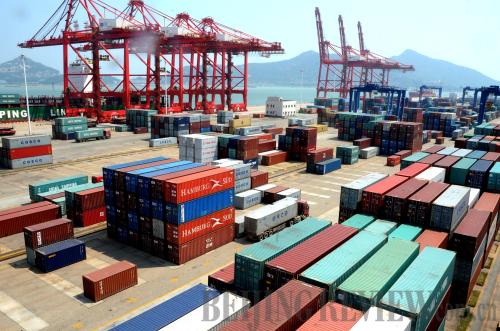Promoting trade in all possible ways
Updated: 2013-08-19 10:50
(bjreview.com.cn)
|
|||||||||||
Foreign trade can play a bigger role in ensuring stable economic growth
Change is coming to the world of e-commerce in China, and it is being driven by foreign trade. The Ministry of Commerce (MOFCOM) is taking the lead, along with the General Administration of Customs (GAC), the Ministry of Finance and the Ministry of Industry and Information Technology, in formulating a policy supporting the development of foreign trade through e-commerce.
|
 |
|
READY TO BE SHIPPED: Containers pile up in the Lianyungang Port in east China's Jiangsu province. |
E-commerce has become a major channel for domestic consumption, with a rising proportion in the total sales of consumer goods. But e-commerce has developed slowly in the realm of foreign trade.
According to the GAC, China's foreign trade grew by 7.8 percent year on year in July. Although monthly growth picked up, it remained at just one third of the growth seen at the start of the year. In January, foreign trade was up by 26.7 percent.
The MOFCOM said in a statement that as an emerging sales channel and trade form, e-commerce breaks through the restrictions of traditional foreign trade sales and is conducive to shortening trade chains, building up independent marketing channels and nurturing new growth points of foreign trade.
In addition to e-commerce, the Chinese government is also promoting the development of foreign trade in all possible ways, including exempting quarantine fees and simplifying customs clearance procedures.
On August 15, the General Administration of Quality Supervision, Inspection and Quarantine and the GAC declared export quarantine exemptions for 1,507 items. According to the GAC estimation, these commodities account for 70.43 percent of the total commodities subject to quarantine, and $44.64 million worth of products will be exempted.
China's foreign trade has been declining this year—the trade volume even saw a 2-percent decrease in June, adding to fears that the target of 8-percent growth in foreign trade won't be realized. The sluggish trade situation also has an adverse economic impact. The export-oriented economic path China has adopted since the reform and opening up some 30 years ago seems to be coming to an end, and ensuring other stable means of growth is a thorny issue for top Chinese decision-makers.
China's slowing economic growth—although in line with government plans to restructure the economy—is unquestionable. In the second quarter, the Chinese economy grew by 7.5 percent over a year ago, which was 0.2 percentage points lower than the rate in the first quarter, hitting the minimum target for growth set by the Central Government at the beginning of this year.
Wang Yiming, executive vice president of the Academy of Macroeconomic Research under the National Development and Reform Commission, said the Chinese economy is moving away from the era of double-digit growth.
Foreign trade, which used to be a major driving force for the Chinese economy, is now surprisingly holding back economic growth. Wang said that when investment has already contributed heavily to economic growth, merely stimulating domestic consumption will not be enough. The government should reinvigorate foreign trade as a primary means of ensuring stable growth, because foreign trade has a bigger space for recovery than consumption and investment do.
Related Stories
China's foreign trade improves in July 2013-08-08 13:20
Henan to boost foreign trade value to $60 billion 2013-07-30 16:31
Good growth in foreign trade in Shanxi in the first half 2013-07-18 18:09
China's foreign trade rises 8.6% in H1 2013-07-10 10:35
Cloudy skies for nation's foreign trade 2013-06-14 07:40
Today's Top News
Be innovative, Premier Li tells graduates
Beijing, Moscow cooperate on floods
New info in Diana's death
Egypt: 36 prisoners killed in violence
Onus on US to improve military ties
Home price rises slow in July
Trustee council may be answer for reforming
40 killed as floods ravage NE China
Hot Topics
Lunar probe , China growth forecasts, Emission rules get tougher, China seen through 'colored lens', International board,
Editor's Picks

|

|

|

|

|

|





